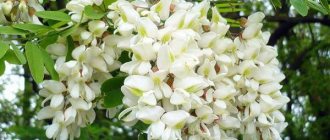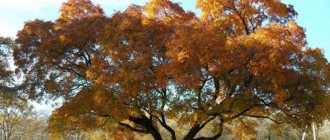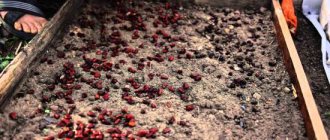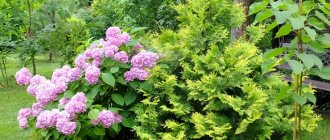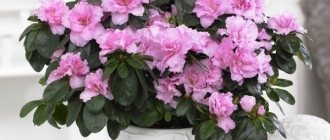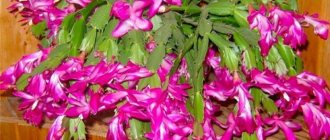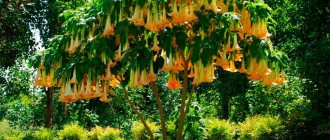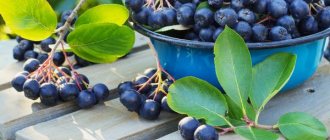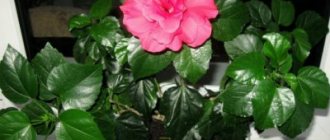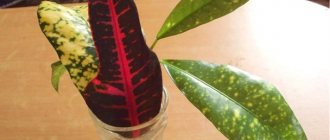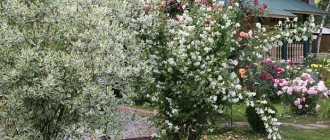Sakura is most often associated with Japan and its culture. Picnics under the canopy of flowering trees have long become an integral attribute of welcoming spring in the Land of the Rising Sun. The financial and academic year here begins on April 1, when the magnificent cherry blossoms bloom. Therefore, many significant moments in the life of the Japanese take place under the sign of their flowering. But sakura also grows well in cooler regions - certain species can be successfully grown even in Siberia.
We have prepared a hearty, incredibly appetizing and simply easy-to-prepare dish for you today. This sauce is one hundred percent universal, as it goes with every side dish: vegetables, pasta, or anything. Chicken and mushroom gravy will save you in moments when you don’t have time or don’t want to think too much about what to cook. Take your favorite side dish (you can do this in advance so everything is hot), add some gravy and dinner is ready! A real lifesaver.
Agriculture is one of those types of human activity, the successful outcome of which is not always directly proportional to the efforts made. Unfortunately, nature does not necessarily act as our ally when growing plants, and often, on the contrary, even throws up new challenges. Increased reproduction of pests, abnormal heat, late return frosts, hurricane winds, drought... And one of the springs gave us another surprise - a flood.
With the arrival of the dacha season, the question arises of growing strong and healthy seedlings of our favorite vegetables: cabbage, tomatoes, sweet peppers, eggplants and many other crops. At the same time, the question arises - how to grow decent seedlings and subsequently get healthy plants and a decent harvest from them? For example, I have been growing seedlings for several seasons now and protecting my garden from diseases with the help of biological preparations Alirin-B, Gamair, Glyokladin, Trichocin.
Let me confess my love today. In love with... lavender. One of the best unpretentious, evergreen and beautifully flowering shrubs that can be successfully grown in your garden. And if anyone thinks that lavender is a Mediterranean or at least southern resident, then you are mistaken. Lavender grows well in more northern regions, even in the Moscow region. But to grow it, you need to know some rules and features. They will be discussed in this article.
Once you have tried such an invaluable product as pumpkin, it is difficult to stop searching for new recipes for serving it to the table. Korean pumpkin, despite its pungency and spiciness, has a fresh and delicate taste. After cooking, you will need to cover the salad and let it sit for at least 15 minutes. My nutmeg pumpkin is very juicy and sweet, so there is no need to mash it. If the pumpkin is of a different variety, you can mash it with your hands so that it slightly releases the juice.
Lettuce, as the earliest and most unpretentious green crop, has always been held in high esteem by gardeners. Most gardeners usually start spring planting by sowing lettuce, parsley and radishes. Recently, the desire for healthy eating and a large selection of greens in supermarkets have forced gardeners to think about which of these plants can be grown in their beds? In this article we will talk about nine of the most interesting, in our opinion, varieties of salad.
The flowering of indoor roses always comes with one more “bonus” - capriciousness. When they say that it is easy to grow roses in rooms, they are lying. For indoor roses to bloom, you need to create literally ideal conditions. And constant care, attention and response to any plant signals is the main key to success. True, no matter how capricious roses may be, they can be grown quite successfully in a potted format. And attentive flower growers should not be afraid of this.
Pollock is best prepared as a casserole, separating the fillet from the skin and bones. Pieces of fish are mixed with a colorful assortment of vegetables and topped with a sauce of cheese, sour cream and eggs. This fish casserole has a presentable appearance, and its taste is a bizarre mixture of subtle nuances. Vegetables and fillets will be soaked in sour cream, the cheese will harden into a golden brown crust, and the eggs will bind all the ingredients together. Pieces of fish are generously sprinkled with Italian herbs, and pollock acquires an unusual piquancy.
Despite the fact that calendar spring begins in March, you can truly feel the awakening of nature only with the appearance of flowering plants in the garden. Nothing signals the arrival of spring as eloquently as clearings of blooming primroses. Their appearance is always a small celebration, because winter has receded and a new gardening season awaits us. But, besides spring primroses, there is still something to see and admire in the garden in the month of April.
Rapidly growing and turning into wild thickets, hogweed disrupts the existing ecosystem and suppresses all other plants. Essential oils contained in the fruits and leaves of hogweed cause severe forms of dermatitis. At the same time, it is much more difficult to control than other common weeds. Fortunately, today a product has appeared on the market that can quickly rid your area of most weeds, including hogweed.
Carrots come in different colors: orange, white, yellow, purple. Orange carrots are dominated by beta-carotene and lycopene, the yellow color is due to the presence of xanthophylls (lutein); White carrots have a lot of fiber, and purple ones contain anthocyanin, beta and alpha carotenes. But, as a rule, gardeners choose carrot varieties for sowing not by the color of the fruit, but by the timing of their ripening. We will tell you about the best early, middle and late varieties in this article.
We recommend a fairly easy pie recipe with a delicious chicken and potato filling. An open pie with chicken and potatoes is an excellent hearty dish that is suitable for a hearty snack; it is very convenient to take a couple of pieces of this pastry on the road. The pie is baked in the oven for one hour at 180 degrees. After this, we lay it out on a wooden surface, having first released it from the mold. It is enough to slightly cool the baked goods and you can start tasting.
The long-awaited spring for many indoor plants is the period of the start of active growing season, and for most - the return of their decorative properties. While admiring the young leaves and emerging shoots, you should not forget that spring is also a great stress for all indoor plants. Sensitive to changes in conditions and universal, all indoor crops face much brighter lighting, changes in air humidity and temperature conditions.
You can easily prepare homemade Easter cake with cottage cheese and candied fruits, even without any pastry experience. You can bake Easter cake not only in a special form or in a paper mold. For your first culinary experiences (and more), I advise you to take a small cast-iron frying pan. Easter cake in a frying pan will not turn out as high as in a narrow pan, but it never burns and is always well baked inside! Cottage cheese dough made with yeast turns out airy and aromatic.
Requires pre-treatment. When prepared, they are much faster, the sprouts grow rapidly and already in the 4-5th year you can expect lush flowering from the plant. The best time to prepare and plant seeds in pots or boxes is the beginning of spring.
Seed preparation involves sawing off the dry and strong skin. You can do this with a fine file or sandpaper. Another option: pour boiling water over the seeds. Then pour the seeds with warm water with the addition of a solution of the stimulant “Zircon”, “Epin” or “Ribav-Extra” (1 drop of the product per 100 ml of water) and leave for two days. It is advisable to change the water to fresh and warm water every 3-4 hours. When the seeds swell, plant them in pots or boxes with soil.
The soil
The soil in which you plan to sow the seeds should be light and loose. You can buy a ready-made universal soil mixture at a specialized flower shop, or you can prepare it yourself. Take 2 parts each of turf soil and peat, 1 part sawdust and a small amount of wood ash, mix. At the bottom of the box or pot, arrange drainage from expanded clay or small crushed stone, pour in the prepared soil, water it with warm water and sow the seeds (shallow). Provided the air temperature is 22-24°C and regular watering, the first shoots will appear in 2-3 weeks (sometimes in 5-7 weeks).
Albizia
| 1. Growing temperature : summer – 18 – 22° C, winter – 7 – 10° C. |
| 2. Lighting : Albizia is sun-loving, but develops well in both natural and artificial light. |
| 3. Watering and air humidity : uniformly moist soil during the growing season should be replaced by almost dry soil when kept cool in the winter months; air humidity should not be increased. |
| 4. Pruning : formative, sanitary, regular pinching of young shoots. |
| 5. Soil : Tolerates a wide range of soil conditions but prefers good drainage. |
| 6. Feeding : during the growing season every 2 weeks, you can feed with both mineral fertilizers and organic matter. |
| 7. Reproduction : stem cuttings, seeds. |
Botanical name: Albizia.
Family . Legumes.
Where does it grow ? Asia, Iran to Japan: Naturalized in the eastern and southern United States.
Albizia description. In mild climates, the plants grow to the size of large shrubs or small trees with smooth, light grey-brown bark and produce fluffy, globular inflorescences of tiny pink flowers.
They do not bloom in pots and are grown mainly for their fern-like leaves, consisting of oblong leaves 6–13 mm long. The leaves are bright green in the spring, changing color to dark red and even chocolate brown in the fall. It grows slowly.
The inconspicuous pinkish and white flowers appear in late summer and develop into flat seed pods in the fall that remain on the plant through the winter.
Height . At home it reaches 150 – 200 cm, grows slowly.
2.1.Reproduction - growing from seeds
It is possible to grow albizia from seeds. In early spring, the seeds are sown in nutritious and loose soil, after soaking them in hot water. Sometimes the peas are so hard that you have to squeeze them with pliers to make the shell burst. The seeds are lightly pressed into the soil without covering the top with soil.
Under a plastic cap or glass, in a warm place, germination takes 2 to 3 months. Every day for 1 hour the cap is removed and the plants are ventilated. Seedlings should be grown throughout the year. Sometimes albizia cuttings are used - propagated in the summer by stem cuttings 10 cm long.
when using powdered phytohormone to accelerate rooting.
↑ ,
↑ ,
2.2.Growing conditions - temperature
The minimum temperature in winter is about 7 – 10 °C; the plant does not like strong summer heat.
↑ ,
2.3.How to grow, pruning
Growing Albizia at home is not difficult. In spring, prune to the 5th or 6th bud to limit the size of the plant and stop the stems from being exposed. Remove old leaves promptly.
↑ ,
2.4.When it blooms
The main flowering time for indoor albizia is early summer, early spring; it blooms very rarely in cultivation. Trees bloom for the first time at the age of 4–5 years.
↑ ,
2.5.Soil for albition
Based on a soil with the addition of coarse sand for good drainage, sandy, loamy soil, prefers well-drained soils, can grow in fairly poor soils, very alkaline and saline.
↑ ,
2.6.Transplant
After a year at the end of winter or early spring in a larger pot.
↑ ,
2.7.Albizia diseases and pests
When the soil dries out, Albizia sheds its leaves, but after the watering regime is resumed, it grows again. Albizia does not bloom in low light.
In the presence of harmful insects on plants, you can notice scale insects, spider mites, and whiteflies.
Insects - pests
| Insect name | Signs of infection | Control measures |
| Whitefly | Small light spots on leaf blades, yellowing and falling leaves. Disturbed white, small butterflies fly up from the surface of the leaves | Chemicals : Zeta, Rovikurt, INTA-VIR, Fufanol and even Karbofos, Aktellik, Aktara, Confidor, Commander, Tanrek. Folk remedies : soap solution, garlic solution, infusion of yarrow and tobacco, infusion of dandelions, sticky traps for adult insects |
| Spider mite | Inconspicuous cobwebs on the leaves, yellowing and falling leaves with extensive damage. The surface of the leaf plates becomes dead and covered with small cracks. Plant development slows down. | Folk methods . Plants can be washed in the shower and left in the bathroom in a humid atmosphere for half an hour. Irradiation with an ultraviolet lamp every week for 2 minutes. Chemical preparations based on pyrethrum, sulfur powders, Fitoverm, Actellik. |
| Scale insect and false scale insect | Sticky droplets on the leaves, small yellow spots on the surface of the leaf blades. When scale insects become widespread, they cause leaves to dry out and fall off. Flowers slow down their development | Folk methods of struggle . Spraying with soap and alcohol solution. Scale insect larvae do not like garlic infusion; they also use pyrethrum-based products. Chemicals . Fitoverm, Aktellik, Fufanon. |
↑ ,
2.8.Lighting
Tolerates direct sun in the morning and evening hours; during the day it requires shelter from the hot summer afternoon sun; it does not grow in the shade. If there is a lack of natural light, artificial supplementary lighting with fluorescent lamps is possible.
↑ ,
2.9.Fertilizer
Albizia in a pot has a limited feeding area and needs additional feeding. During the growth period, fertilize every 2 weeks with diluted liquid fertilizer. The plant responds positively to organic fertilizers.
↑ ,
2.10.Spraying
There are no special requirements; at home, Albizia can do without spraying.
↑ ,
2.11.Watering albizia
Abundant watering during the period of active growth, moderate in autumn and limited in winter, drought-resistant.
2.12.Purpose
This plant is considered mainly as a temporary houseplant that is thrown away after 2 – 3 years. Large plants are used as tubs. It can be grown using the bonsai technique. At night, the leaves of the bush curl up.
2.13.Note
In Eastern medicine, the bark is used as a sedative, analgesic and tonic. Bark extract is believed to help with insomnia and irritability.
Hydroponics.
Transfer
When it reaches a height of 2-3 cm, you can transplant each sprout into a separate pot or several pieces into a deeper and more spacious box with a distance between sprouts of 15-20 cm. The soil can be of the same composition as for sowing the seeds. Don't forget good drainage. This period - until next spring and the time of planting in a permanent place - is very important for acacia. Those plants that have safely overwintered indoors and by the end of the first year of life have grown 50 cm or more have a good chance of taking root and blooming in 3-4 years.
How to propagate acacia from cuttings
Propagating acacia by cuttings is one of the easiest ways to grow a plant. This procedure is carried out in the spring or late summer, while the weather is still warm and the cuttings have every chance of rooting and developing. The tops of shoots are used for propagation. Acacia cuttings are cut at an angle, cutting off shoots 10 cm long. For better rooting, the ends of the shoots are dipped in a solution of Epin or Zircon for six hours. During this time, prepare a nutrient substrate: take a ready-made mixture for flowering plants, sand, “Vermiculite” in proportions 1: 1: 0.5. Add charcoal in pieces to the prepared mixture.
Important! When planting acacia seedlings, a good layer of drainage, compost and a complex of mineral fertilizers are placed at the bottom of the hole. A nutritious substrate for acacia is one of the main conditions for the successful development of young plants. Before planting, the soil is evenly moistened, the cutting is deepened into it and covered with a cap (plastic bottle)
The box with cuttings is placed in a warm place with a temperature not lower than +22 ° C, with good lighting. If you provide heating from below, this will significantly speed up the rooting of acacia cuttings. Usually the rooting process is completed in two to three months.
Before planting, the soil is evenly moistened, the cutting is deepened into it and covered with a cap (plastic bottle). The box with cuttings is placed in a warm place with a temperature not lower than +22 ° C, with good lighting. If you provide heating from below, this will significantly speed up the rooting of acacia cuttings. Usually the rooting process is completed in two to three months.
Did you know? The ancient Egyptians revered the acacia tree as the tree of life. Because of its yellow flowers, acacia was considered a symbol of the sun and a symbol of the god Horus. Ships were built from Arabian acacia wood in Ancient Egypt.
Warnings from experienced gardeners
Do not plant acacias close to them; an overgrown one can suppress their root system.
Already in the first year of life, the acacia will produce shoots from the roots, which grow very quickly (up to 2 meters per year) and which are very difficult to remove. Therefore, you should not create beds or plant flower beds near the acacia. Let there be more free space so that emerging young growth can be removed in a timely manner and without problems.
Keep in mind that flowering acacia is a strong attraction for bees. If this doesn’t bother you, you can plant a tree next to your house or gazebo. If it's a concern, plant it away from the porch.
Acacia grows large and sharp thorns, and its seeds are not suitable for food (moreover, they can be poisonous), so do not let small children get close to it.
Growing yellow acacia, or Caragana arborescens, is rewarding work. It has found its application in folk medicine and beekeeping. Yellow acacia is lower than white acacia, it is easy to cut, so it is actively used for decorative landscaping of the area. Caring for the shrub is quite simple; even a beginner can grow it.
How to plant yellow acacia
Caragana is very undemanding, so it is often planted along roads, used to protect fields from wind erosion and strengthen various slopes. And yet, in order for the plant to fully demonstrate its qualities, well-lit areas with light, moisture-absorbing soil are chosen for the shrub.
If you are going to plant an acacia tree for a living wall, leave a distance of 50–70 cm between the plants. Gradually, the crowns of the bushes will close together, and regular pruning will help form a fence of the required height, width and shape.
The maximum width of a yellow acacia bush can be 5 meters. This is taken into account when planting alone so that surrounding plants do not fall into the shadow of the fast-growing caragana, which can live up to 50 years.
Optimal time for planting shrubs:
- early spring, when the soil has thawed sufficiently, but the buds on the acacia have not yet awakened;
- autumn, when the growing season ends and leaf fall begins.
Before planting yellow acacia, prepare planting holes with a depth and width of at least 50 cm. Sandy soil and sandy loam are mixed with organic matter, a small amount of low-lying peat and 100–200 grams of complex mineral fertilizers. In heavy dense soil, in addition to the above, you need to add sand. This allows the plant to actively develop the root system and quickly take root in a new place. A drainage layer 10–15 cm thick is laid at the bottom of the pit.
After the seedlings are immersed in the holes:
- they are covered with prepared soil;
- the soil is compacted;
- planting sites are watered abundantly;
- The tree trunk circles are thickly mulched.
On this topic:
BACK
FORWARD
1 of 2
Reproduction
A significant difference between yellow acacia and most is that it reproduces well using seeds (generatively). Planting in open ground is carried out from September to mid-October in moderately moist soil. Some gardeners practice growing shrubs in flower pots. With this method, the seeds are sown immediately after collection in a mixture of garden soil and sand (ratio 3 to 1). It is very important that the container has drainage holes, because acacia does not like excessive moisture. They feed it and transplant it into open ground in the spring, no earlier than after 1 year.
The shrub also reproduces well using root layering and division, cuttings, and root shoots. Cuttings are carried out in the spring, and layering and division - in the fall (after the caragana sheds its leaves). Proper care and fertile soil ensure good plant growth; in a year its height can reach 1 meter. Yellow acacia usually begins to bloom in the third year of life.
Caring for a tree in the garden
Exotic acacia is unpretentious in care, but this does not exclude the observance of basic agrotechnical measures. Given comfortable growing conditions and appropriate care, it will delight its owners for decades.
Watering and mulching
Throughout the growing season, albizia is watered frequently, preventing the top soil layer from completely drying out. Use separated water. The plant should not be over-watered, which will lead to rotting of the roots. After each watering, the soil in the space around the trunk is loosened and weeds are removed. Since Albizia prefers loose soil and in order to avoid its compaction, it is not advisable to often walk near the plantings.
You can improve the soil structure by mulching with humus, grass clippings or peat. In addition, such a protective layer prevents the rapid evaporation of moisture and inhibits the intensive growth of weeds. It is enough to resort to this procedure once in the spring.
Feeding
Albizia begins to be fed from the second year of life. Fertilizers are applied from spring until the end of the growing season. There should be three of them in total:
- Just before the buds open. Use any fertilizer containing nitrogen (for example, ammonium nitrate) in dosages according to the instructions. Sprinkle the product around the bush at a distance of half a meter from the base and lightly press it into the ground. After rain it will wash away and be absorbed by the roots.
- During the formation of flower stalks. Choose complex mineral compositions (nitroammophoska, potassium humate, Kemira Lux). The optimal dosage is 3 tbsp. l. per 1 sq. m. landing.
- After flowering. Potassium-phosphorus preparations (superphosphate, potassium sulfate) are added, which will help prepare the plant for winter. 2-3 tbsp will be enough. l. powder per 1 sq. m of planted area. It is scattered and covered with a layer of humus about 10 cm on top.
Trimming
Albizia must be periodically pruned not only to give the tree a decorative appearance, but also to slow down its growth. This is done in early spring before the buds begin to form. The crown is thinned out by cutting off excess shoots, as well as frost-damaged, weakened and dry branches. In this way, it is possible to protect the plant from diseases, since in damaged areas there is a high risk of developing pathogenic microflora.
Wintering
An adult Lankaran acacia can tolerate cold temperatures down to -16 °C. But young plantings that are not yet a year old are especially sensitive to frost and may die. Therefore, it is recommended to prepare them in advance. For protection, use sheets of cardboard or foam rubber, which are rolled into a pipe and placed on the tree. The root space is insulated using natural means: peat, humus, fallen leaves and other plant waste from the garden. The soil is covered with polyethylene.
On mature trees, shoots are cut to half and the root collar is hilled up. Throw any non-woven material on top, fixing it on the sides with stones.
Table: problems encountered when growing albizia and ways to solve them
| Painful manifestations | Causes | Correction Methods |
| Dropping leaves | Over or under watering | Normalize the watering regime |
| The appearance of brown spots on leaf blades, curling of leaves at the edges | Problems with the composition of the soil or the location of the tree in a draft | Transplant the plant to a new location |
| Underdevelopment of buds and their premature fall | Lack of moisture | Water more often |
| Loss of rich color in leaves | Deficiency of light or nutrients in the soil | Change the location of the albizia, add additional fertilizing |
Disembarkation
Planting of seedlings is carried out before the leaves develop, that is, in early spring. To plant in the nursery, the seeds are pre-soaked for 5 hours in water at room temperature. Stratification methods are also used (imitation of natural winter conditions to stimulate plant growth), in which snowing of seeds is carried out for 45 days. You can keep them in the refrigerator at 0 degrees for 30 days. Seeds are planted in the nursery at a depth of 2-3 cm, sowing density is 10 pcs. per 1 square meter. After a year, the acacia is transplanted into open ground.
Tree sandy loam is ideal for caragana, but it grows well in other types of soil. In order for the plant to grow healthy, seedlings are planted in a hole sprinkled with gravel or crushed stone (2 kg per one). It is also recommended to add complex fertilizers or compost. The optimal distance between holes is 50 cm, and the planting depth is 40 cm (the root collar can be deepened by 1.5 cm). If yellow acacia was grown in a peat pot, then it is planted with it. Then the soil around the seedlings is mulched with a layer of 5 cm. Pine needles, hay, peat, bark or sawdust are best suited for these purposes.
This is interesting!
An interesting fact is that yellow acacia does not threaten biological diversity, while its common counterpart, white acacia (or black acacia) is an invasive species (disturbs the nitrogen cycle in the soil). That is, growing caragana tree is absolutely safe for the ecosystem.
Albizia Lankaran (Crimean acacia): description of the plant
A plant of incredible beauty that has an equally poetic name. One of the brightest representatives of the legume family, native to tropical latitudes.
Tour operators often print picturesque photos of her to attract tourists. A plant that can feel equally good both in nature and at home.
Lankaran acacia can rightfully be called the princess of the Albizia genus.
Silk acacia - what kind of tree is it?
Lankaran acacia (Albizia julibrissin) is the most decorative species of the Albizia genus with delicate pink flowers, for which it is often called silk.
Albizia can often be found growing in open ground in the south of our country - the Black Sea coast of the Krasnodar Territory and in the Crimea. Therefore, it is no coincidence that the name Crimean or southern acacia is fixed in our language.
Depending on growing conditions, it can take the form of a tree or shrub. This albizia can also be grown indoors, with proper care.
https://www.youtube.com/watch?v=cUxQT27yRV0
It owes its name to the Florentine del Albizzi, thanks to whom Europeans first learned about this plant. The second part of the name means “silk flower” in Farsi.
In addition, silk acacia has many unofficial names: Chinese acacia, Turkish albizia, Persian silk tree, albizia, silk acacia and others.
The homeland of albizia (where it comes from) is considered to be the area of Lenkoran in the south-east of Azerbaijan.
Albizia Lankaran is a deciduous tree, its height can reach 16 meters (on average - from 6 to 9). The crown of the plant is spreading, formed in the form of a huge openwork umbrella. The root system of silk acacia is well developed, but superficial.
Because of this, the frost resistance of the silk tree is insignificant (it can withstand frosts down to minus 15 ° C for a short time), this is enough for growing on our Black Sea coast, but not enough for growing in open ground, for example, in the conditions of the Moscow region.
Albizia Lankaran - tall deciduous tree
The leaves of Lankaran albizia are unpaired, bipinnate, dark green on top and whitish on the underside.
The central petiole contains from 9 to 15 lobes, which in turn contain about 30 pairs of crescent-shaped leaflets.
In the evening and in hot weather, the leaves of silk acacia fold along the central petiole and droop. Because of this, Albizia Lankaran is sometimes called the “sleeping tree.”
Acacia flowers are yellowish, bisexual. The corolla is funnel-shaped, yellow-green in color, poorly defined. Long (about 3.5 cm), bright pink stamens protrude from the corolla.
The corolla with stamens is located inside the bell-shaped calyx. Albizia Lankaran flowers are collected in fluffy spherical inflorescences. Flowering begins in July and continues until the end of August.
This “silky acacia” blooms so impressively that it becomes a real event.
Albizia Lankaran flower formula: ♀♂ ↑Ч5Л1+2+(2)Т(9)+1П1
The fruits of silk acacia are elongated double-leaf beans, about 20 cm long. When ripe, the pods are dry, yellow or brown. In winter, Lankaran silk acacia sheds its leaves and goes into a dormant state.
The tree grows very quickly and, under favorable conditions, can live up to 100 years (on average, about 50). The plant is listed in the Red Book as an endangered species.
Albizia Lankaran flowering
In the nature of Russia, Lankaran silk acacia can only be found on the Black Sea coast. Crimea is especially famous for its alleys of albizia, for which it is often called the southern or Crimean acacia.
Silk tree in landscape design
Albizia Lankaran is a southern plant with poor winter hardiness, so when creating landscape compositions, this important factor must be taken into account.
Since silk albizia looks luxurious both as a single tree and next to other plants, this is successfully played up by landscape design masters. It will fit perfectly both in the garden plot and on the city alley.
Due to the fact that the leaves of Lankaran acacia transmit the sun's rays, light-loving plants can be planted under it.
And in combination with a swing or a picnic table, a silk tree will fill the garden with romance, tenderness and comfort.
Tunnel alleys look especially advantageous in the urban landscape. To do this, Lankaran acacia is planted on both sides of the path or path. The older the plants become, the more they spread their crowns over the path, forming a green tunnel.
Lankaran acacia planting and care
There are several ways to grow silk albizia at home:
- from seeds;
- cuttings;
- transplanting root shoots.
It is recommended to start growing Lankaran albizia from seeds in the fall. It is believed that at this time of year its seeds have a higher germination rate. Before planting, seeds need stratification.
To do this, they are placed in warm water until they swell. After this, the seed material is planted in a substrate made of a mixture of sand and peat. The first shoots appear a few months after planting.
At this time, it is necessary to maintain the temperature above 20 degrees and prevent the soil from drying out.
Albizia seeds
When propagating Lenkoran acacia by cuttings, you need to take half-lignified cuttings from the side shoots. It is recommended to carry out the cutting cuttings procedure at the beginning of summer.
The length of the cutting can be 10-15 cm. Next, the cut shoots are planted in a sandy-peat substrate.
It is recommended to remove the seedlings to a cool place and, after rooting, plant them in separate containers.
Root shoots can be propagated if you plan to grow the plant in open ground. In this case, part of the root shoots of the parent tree is taken and transplanted to another place.
When growing albizia in open ground, you should remember that the plant is light-loving and will not tolerate shading neighbors near it. She also loves moist soils, but can tolerate drought for some time. It tolerates sanitary pruning of dead shoots very well.
Albizia seed sprout
The southern beauty may not be able to withstand the harsh winter conditions of the Moscow region. Frost below -18 °C is already destructive for the silk tree, although isolated cases of plant acclimatization are known in central Russia and even in Siberia.
A good option for open ground would be to trim young shoots and wrap the root collar. And even so, there is no 100% guarantee that the plant will survive.
The ideal option is to grow Albizia Lankaran in greenhouses or indoor conditions as an ornamental plant.
Disease and pest control
Silk Lankaran acacia has good immunity to various diseases and pests. In indoor and greenhouse conditions, it can occasionally suffer from spider mites and scale insects. When grown in open ground, it practically does not get sick (unless it freezes).
When a scale insect attacks, noticeable brown insect growths appear on the branches of albizia. Removing them so as not to harm the plant bark is quite difficult. It is best to use a sponge or cloth moistened with an insecticide.
When a spider mite invades, thin, barely noticeable cobwebs appear between the branches of albizia, and the leaves become covered with a white coating. If no measures are taken, the acacia leaves dry out and the plant begins to leaf out.
You can get rid of this pest not only with insecticidal preparations, but also with folk remedies. For example, use tobacco dust or spray the plant with infusions of garlic and onions.
Improper care can also cause silk tree disease:
- With a lack of moisture, dark spots appear on the tips of the leaves.
- With excessive watering, the root system suffers.
- If the earthen coma dries out, flowering may not occur.
- Insufficient lighting leads to a change in the color of the foliage, it becomes dull and faded.
- If the plant is in a draft, chlorotic spots appear on the leaves.
How to grow bonsai from Lankaran acacia
Since silk albizia responds well to formative pruning, you can try growing it in the form of a miniature tree - a bonsai.
First, you should decide on the shape of the future tree. In nature, albizia most often has a multi-stemmed form or powerful lateral branches on a short central trunk and an umbrella-shaped crown. But, due to the fact that acacia produces new stem buds well, you can choose any style of bonsai.
You can grow Albizia Lankaran bonsai using both cuttings and seeds. When growing you should remember:
- a container for growing bonsai should be small, ceramic, with large drainage holes;
- In no case should the lower branches be allowed to be shaded, otherwise they will die;
- It is best to trim the roots and crown after flowering;
- periodically you need to perform corrective pruning of the crown;
- winding with wire to give the branches shape should be done no more than once every two years and for no more than 4 months;
- When winding with wire, do not tighten it too much, as this can damage the plant bark;
- since acacia leaves have a complex shape and add decorative properties, their artificial removal does not give any effect and is therefore not used;
- Bonsai must be replanted every two years.
The most acceptable height of a miniature silk tree is about one meter.
https://www.youtube.com/watch?v=xSHL26l44X4
This is how you can turn a silk Persian tree into a real work of art. This will add a southern flair and will be a great addition to any interior.
Acacia Lankaran - medicinal properties
Albizia Lankaran is a heat-loving honey-bearing tree or shrub (the form taken depends on the growing conditions), but unlike white acacia (Robinia), Albizia honey has a small distribution.
It is not included in the lists of pharmacopoeial plants, but is often used as decoctions (teas) and tinctures in folk medicine for increased irritability, insomnia and arrhythmia, as well as for gastrointestinal disorders and inflammatory diseases of the skin.
Contraindications and warnings
Contraindications to the use of albizia as an alternative medicine may be:
- pregnancy;
- renal and liver failure;
- ischemic disease;
- stroke;
With caution - during lactation and for oral use in children under 12 years of age.
Source: https://cvetydoma.ru/cvety-i-rasteniya/albitsiya-lenkoranskaya.html
Description of the species
Albizia Lankaran amazes with its beauty residents and guests of the southern regions of our country. Compared to other deciduous tree species, this species does not have such a long life span, on average about 50 years. Has the following characteristics:
- reaches a maximum length of 9 meters;
- the crown shape of the Lankaran acacia is spreading, umbrella-shaped;
- the root system develops on the soil surface, but is strong and powerful;
- From afar, silk acacia leaves resemble fern leaves. At night, they fold along the base and droop, blooming again in the morning, and fall off in late autumn;
- the buds swell and bloom in April;
- the flowers are collected in pink corymbose inflorescences. Appear on the tree throughout the summer;
- the fruits of a bush or tree are pods up to 20 cm long. They contain seeds - brown beans, the average size of which reaches 7 mm.
Spreading
In Europe they learned about this unusual tree in 1740, thanks to the Florentine Filippo del Albizzi, who brought it from Constantinople. Since then, silk acacia has spread to East, Southeast and Western Asia, the Indian subcontinent and the southern United States. In Russia, this species is distributed in the south of the Krasnodar Territory and in the Crimea.
Planting and care
Lankaran acacia, thanks to its root system, which is partly located on the soil surface, easily tolerates short-term drought. Therefore, when planting, it is not necessary to look for well-moistened places. But you need to take into account the air temperature, which in summer should not fall below 25 degrees, and in winter below minus 8 degrees.
It is recommended to plant seedlings in open ground in early May in a well-lit place. It is necessary to harden the seedlings in advance by taking them outside for a while, gradually increasing it.
To plant a plant, first, you need to dig a hole that is about 30 cm larger than the earthen ball and fill it one-third with drainage made of pebbles or expanded clay. Place the plant in the ground and sprinkle it with soil having the same composition in which it grew. The root collar should be one to two centimeters above the ground surface. You need to water carefully, distributing the water around the seedling.
In spring or autumn, when there are no leaves on the acacia, it is recommended to carry out sanitary pruning of dead shoots. In too dry times, it is better to water the plant, but not too much. Excess moisture can be detrimental to it.
Water for irrigation should be clean, not cold. Watering with cold water in hot weather is contraindicated for this type of acacia. During the growth period of the plant, that is, from May to July, you can feed it with fertilizers.
Mulching with humus or compost will help get rid of weeds, drying out and serve as fertilizer.
Meaning and Application
Lankaran acacia is a honey plant. But they appreciate it not only for its beauty and delicious honey. It is a medicinal plant listed in pharmaceutical reference books. Flowers and tree bark, which are harvested in the summer, are considered medicinal. The bark is crushed and dried together with the flowers outdoors in the shade or in a well-ventilated cool room.
The healing properties are manifested due to the content of essential oils, tannins, amino acids, vitamins and minerals contained in the bark and flowers of acacia. Infusions, teas or decoctions are prepared from them.
A decoction of flowers and buds is used to treat depression, stress, insomnia and other nervous disorders. Tea made from flowers has a beneficial effect on digestion and eliminates flatulence.
The bark also has healing properties for the nervous system, but is also an anti-inflammatory agent for purulent diseases and diseases of the musculoskeletal system.
To treat such diseases, moistened bark powder is applied under a bandage to the affected area.
In industrial production, albizia bark is used to dye wool and silk in yellow or brown tones. Lankaran acacia wood is used for making crafts, souvenirs, dishes or interior furniture.
Use in landscape design
In our country, only residents of the southern regions can use silk acacia in landscape design, due to its susceptibility to frost.
It looks great with other trees that do not shade it. But it looks best next to decorative buildings, swings or small gazebos.
It is very cozy and comfortable to relax on a bench under the wide spreading crown of this tree.
There are lovers of Lankaran acacia not only in the south. Due to unsuitable climatic conditions, they grow this plant as a shrub at home or in a greenhouse. Home care is not much different. But the beauty of the plant always pleases its owners.
Source: https://lesoteka.com/derevya/lenkoranskaya-akatsiya
How to care for acacia?
Due to its structure, yellow acacia adapts to any weather conditions and temperature changes, so caring for the plant is easy. An adult shrub can withstand both intense summer heat and winter frosts; it does not need to be covered. Acacia is not afraid of strong winds and drafts; it itself can serve as protection for other plants. Caring for her is as follows.
- Lighting.
Yellow acacia is photophilous; it does not get burned even under the scorching sun, so seedlings should be planted in well-lit areas.
- Soil moisture.
The shrub does not grow well in marshy, low-lying areas.
- Watering.
Caragana arborescens tolerates dry periods more easily than excess moisture. Stagnation of water very quickly leads to rotting of the root system. Therefore, it is necessary to water the shrub no more than 3 times a week, as the soil dries out. Each adult plant requires approximately 12 liters of water.
- Fertilizers.
Plants are fed from March to August, approximately once every 2 weeks. You can do this only in early spring and before flowering. Mullein diluted in water or mullein is excellent for fertilizer. Mature shrubs are usually not fertilized; caring for them consists of timely watering and pruning.
- Trimming.
Crown formation should begin no earlier than in the second year of life. It is best to do this in the spring or immediately after flowering. To prevent the plants from growing tree-like (like white acacia), it is recommended to cut them heavily in the second year, leaving only 2-3 buds. This method stimulates the formation of a bush form.
Yellow acacia grows strongly, so it is necessary to provide free space around its planting site.
Acacia pruning
Pruning is very important to maintain the decorative appearance of the tree and protect it from diseases. Acacia is pruned starting from the second year of life, after it fades. A two-year-old acacia needs to be completely cut off, leaving three buds, so that it does not become woody. This is necessary for better development of the crown and its acquisition of a bush-like shape.
During subsequent pruning, only damaged and diseased branches should be removed. To help the bush recover faster, after the procedure it should be fed with nitrogen fertilizers.
Application
The shrub is widely used in landscape design; it is ideal for strengthening sandy soils. In addition, its crown is perfectly formed into various shapes; you can even create entire compositions with other trees and shrubs. Caring for them is easy, and pruning is not difficult even for a beginner. To form a hedge, acacia is planted in a checkerboard pattern with a sowing density of 25 cm.
In addition, like white acacia, caragana is valued for its medicinal properties. Its flowers are added to tea, which gives it a sweet taste and pleasant aroma. This drink is useful for drinking in case of ARVI, hepatitis, diabetes mellitus, arthritis, atherosclerosis, as well as a lack of vitamins A and C. Cargan arborescens has anti-inflammatory, antispasmodic, expectorant and antipyretic effects.
Both yellow and white acacia have excellent honey-bearing properties. This honey is valued for its delicate taste, subtle pleasant aroma and light amber hue. It does not crystallize for a long time, maintaining its transparency and freshness. Yellow acacia honey increases the body's defenses and has an antimicrobial and mild sedative effect.
As you can see, caring for yellow acacia is quite simple. Cargana tree, like Robinia false acacia (white), belongs to the legume family, reproduces easily and is not afraid of winter frosts. It easily endures hardships and hardships along the roads, and perfectly protects other plants from the wind. During flowering, it emits a pleasant sweet aroma, which is very attractive to bees. Therefore, it is better to plant it away from entrance doors, gazebos and playgrounds.
Planting acacia is also quite simple. You can simply bury the seeds in the ground in early autumn. Having overwintered under thick snow, in the spring they will produce young green shoots. And after 2–3 years, a real hedge will appear in their place.
Almost everyone knows what white acacia looks like. And, despite the fact that in fact this plant belongs to the genus Robinia and is only distantly related to real acacias, this name has taken root among the people much more firmly than the real one. Therefore, this plant is often also called black acacia or black acacia, as well as common acacia.
Lankaran acacia
Albizia julibrissin, synonym Lenkoran acacia, silk acacia or silk tree. Albizia Lankaran belongs to the legume family (Fabaceae), a low ornamental tree that looks spectacular during mass flowering.
Description
The tree forms a wide umbrella crown. The annual rings have a dark greenish coating of bark. The bark of lignified branches is gray, sometimes vertical light spots are visible. Many shoots have a zigzag shape.
The leaves are openwork, bipinnate, grow up to 45x25 cm. Because of the leaves that close at night and during rain, it is known in the world as “ Persian mimosa ” or “ Sleeping tree ”.
A double complex inflorescence appears at the top of the shoots. A single flower is collected in a capitate inflorescence, the inflorescences are collected in loose panicles. The flowers have no petals; instead of petals, there are long threads of stamens growing from a greenish bowl. The flowers are honey-bearing and fragrant, especially at night. In nature, flowers are pollinated by moths and hummingbirds.
The fruit is a long (10-20 cm) pod containing several large seeds.
There are two botanical varieties:
- Albizia julibrissin var. julibrissin
- Albizia julibrissin var. Mollis. Differs from the described species in dense hairs on the shoots.
There is also a form of Albizia julibrissin F. Rosea - a smaller tree with pink flowers. Since it is found in the northernmost regions of North Korea and China, it tolerates much lower winter temperatures than species.
There are selective varieties. Popular ones are:
- “Chocolate Summer” has dark carmine brown leaves and pale pink flowers.
- “Ishii Weeping” (or 'Pendula') - distinguished by the drooping shape of the shoots.
Natural habitats are South and East Asia, from Iran to Korea, China to Japan, Crimea. Height in nature up to 12 meters.
Lankaran acacia, planted in open ground, rarely reaches 4 meters, at home - 2-2.5 meters. Flowering , in the warmest part of summer, when the temperature difference between day and night is not too high.
The color of the flowers, the stamens, are white right on the cup, gradually turning into pink.
Landing
When growing in open ground, two conditions must be met. Plant in a sunny, sheltered place .
When grown in a container outdoors, place it under the midday sun (after hardening), when grown at home, provide the most illuminated place, with sunlight only in the morning.
The southern sun behind the glass will burn the leaves. Later, Lankaran acacia will shed damaged leaves.
Care
When growing outdoors, you don't have to worry about the soil. On one condition. The soil must be permeable. The secret to surviving albitia in the ground is planting it after 3 years of growing in a container.
We are talking about a partially or completely woody plant that will survive the winter. Zone 7a and 7b. There may be a risk of outdoor cultivation in the western part of zone 6b.
The top priority is a well-protected location.
Keeping the soil slightly moist for quite a long time after planting will help the plant take root well. A good root system increases the chances of winter survival. For safety, you can dig around the acacia no lower than 30 cm. The base of the embankment should be wide.
It is assumed that the most important are the roots located on the circumference of the shadow that the crown of the tree casts in the southern hours. If a cold winter destroys the shoots above the embankment, the frozen parts of the acacia are removed in the spring, and new shoots with a high growth rate (up to 1 meter per year) will grow from the dormant buds under the embankment.
The tree will become a bush. A shrub is easier to protect for the winter than a small tree.
When grown in containers, the basis is a permeable substrate. The cheapest leavening agent used is aquarium gravel. The smallest grain is purchased and mixed in half with the soil. Since even large pots are light, several large stones are placed on the bottom - previously well washed, there will be a drainage layer and a stability stabilizer.
After transplantation, the substrate in the pot is kept in a state of light moisture during the growing of the acacia. If the substrate has poor permeability, be careful with watering. It is not good to dry out the soil; it is even worse to over-moisten it. Lankaran acacia is susceptible to diseases caused by waterlogging, a practically incurable disease called fusarium .
Preparing the right substrate should not be underestimated. Since acacia grows quite quickly after 6-8 weeks, fertilizing is done. Use a universal fertilizer for potted plants. If Albizia starts to set buds, switch to fertilizers for flowering plants. In mid-September, the application of fertilizers is limited.
Firstly, half the dose is applied; from mid-October, the plant is fertilized with half the dose, every month.
When growing Lankaran acacia outside, bring it into the room the night before the first frost. Indoors, Albizia is installed in the brightest place without direct sunlight during the daytime. Morning or afternoon sun will not harm the plant.
Frost resistance
In our country, only A. julibrissin f. can be grown. rosea, resistance is -25 °C. It should be remembered that a one-time occurrence of low temperature and persistence over a long period of time are two different things.
Reproduction
Propagated by sowing seeds. Seeds remain viable for a long time. The main condition is a suitable substrate for sowing. The substrate cannot be rich in fertilizers; the plant must create a reliable root system with appropriate efforts.
The soil for flowers is full of pathogens, often the seeds germinate well, and 10 cm seedlings begin to fall - fusarium or blackleg. For sowing, a specially prepared substrate is used.
In the spring, it is not difficult to buy a substrate called “ sowing soil ”.
Due to their hard shell, the seeds need to be prepared. Sometimes it is enough to put the seeds in warm water and put them on the radiator for a day. Some seeds will need a second day. You can help by using sandpaper. Seeds are sown one at a time in small pots. The seedlings cannot tolerate transplantation because of their long roots and can be broken; it is better to sow one at a time.
It is better not to sow for the winter. Seedlings require good lighting.
Diseases and pests
The main enemy of Lankaran acacia is a fungal disease called fusarium. The mycelium clogs the vascular bundles and the plant falls. Even a small excess of water contributes to the emergence of a pathogen .
Notes
The Latin name “Albizia” comes from the name of an Italian nobleman, Filippo del Albizzi, who brought the plant to Europe in the mid-18th century. The name “julibrissin” comes from the ancient Persian language, meaning “silk flower”, where jul = “flower”, abrisham = “silk”.
Because the plant drops its leaves at night, it is known by the standard name " dormant tree " in Asia.
Source: https://floral-house.ru/listvennye-derevya/lenkoranskaya-akatsiya.html
General description of white acacia
White locust is native to North America, but is now also found in Latin America, New Zealand, Africa, Australia and Europe. At the beginning of the 19th century, the seeds of this plant were imported into Russia, and already in 1859 the first publication on the beneficial properties of white acacia was published.
In its homeland, the white acacia tree can reach 30 meters in height and about one and a half meters in trunk diameter. The spreading crown can be twice as wide as the tree. The “umbrella” shape of the crown indicates that the plant is a savannah, adapted to a lot of sun and dry wind blowing from the side. When acacia is planted densely, such a crown turns into one-sided, since one of its parts does not have enough light. And, naturally, white acacia is very resistant to drought, otherwise it would not survive in savanna conditions.
The combination of two such properties as drought and frost resistance makes this plant almost the most popular for parklands in the steppe zones of Russia and Ukraine. White acacia is even a symbol of the city of Odessa.
Robinia vulgare played a special role in 1930-50, when it was used to create forest shelterbelts. The powerful root system of the plant helped prevent the then-threatening large-scale soil erosion caused by the plowing of virgin lands.
Robinia is also resistant to polluted, gassed city air and industrial emissions. It is this property that makes it the main “street” tree. White locust survives even in the heavily polluted centers of large Russian cities such as Moscow. Moreover, they even bloom successfully in such conditions.
Including, this plant is an excellent honey plant. Bees are able to collect 400-600 kg of honey per hectare of Robinia plantings. Acacia honey has a greenish-yellow color with a faint odor, which does not tend to become sugary even after long-term storage.
But you should know that acacia berries are poisonous and inedible for livestock.
Description of Robinia
Robinia, Latin - Robinia. Large trees 20-25 m high (can reach 30-35 m), openwork, spreading crown. The buds are extremely small and not visible at all from a distance; annual shoots are faceted, angular. The leaves are light green, imparipinnate, 20-30 cm long, consisting of 7-19 elliptical leaflets 2-4 cm long; yellow in autumn.
The flowers are white, highly fragrant and rich in nectar, up to 2 cm long, collected in drooping racemes 10-25 cm long.
The fruits are flat brown beans, 5-12 cm long, ripening by the end of September. Browned fruits remain on the tree in winter and into the next year. The seeds are narrowly kidney-shaped, brown, matte, smooth, and contain up to 12% semi-drying oil.
The annual growth is 60-80 cm in height, 20-30 cm in width.
Robinia bristle-haired. © Ruth Hartnup
Planting and care
Since robins are fairly resilient and unpretentious plants, they are quite easy to grow. Only two conditions are important - plenty of sun and lack of groundwater in the place chosen for planting. If your site is located in a swamp or forest, then you will have to abandon the idea of \u200b\u200bgrowing acacia.
White acacia reproduces by root suckers and seeds. Moreover, the second method does not require as much time as it seems at first glance. To begin with, before planting, the seeds need to be treated with boiling water: place the seeds prepared for planting in it for 5-10 seconds, and then throw them into cold water. This is done so that the outer shell of the seeds cracks and they swell.
Seeds treated in this way should be sown immediately. This can be done in April in a box or in May in a greenhouse. For the growth of good seedlings, a high temperature of up to 20 degrees is required, and they must live in a cold spring in a greenhouse with small tomato bushes. In early to mid-June, the plants are planted in a separate illuminated bed.
Everyone knows that robins are a leguminous plant, and therefore are in good symbiosis with bacteria that absorb nitrogen from the air. Therefore, some gardeners believe that the plant does not need fertilizers. In general, if the seedlings are left on a starvation diet, they will still survive and even grow 10-15 cm by autumn. But they will have to grow for at least another two years. But few people want to wait these two years, right?
To prepare seedlings well, you need to prepare the ground well. Legumes love alkaline soil, so it is recommended to add a lot of compost and ash. When planting seedlings, it is necessary to maintain a sufficient distance between them; the planting size should be 30*30 cm. Young plants require regular watering, complex fertilizer, and weeding. If the summer is warm, then in the fall many seedlings will be a meter high, and some will even produce side branches. Such trees will already be ready to be transplanted to a permanent place, but there is still no need to rush, it is better to wait for spring.
Propagation using root suckers is somewhat easier, but the same productive effect is not observed. To do this, you need to dig up the rhizome with a young plant and transplant it to a new place.
There is a third method of propagation, which is quite effective - propagation by root cuttings. For this, at the beginning of May or in the middle of this month, you need to carefully dig out several lateral roots of an adult plant. The diameter of the cutting should be 5 mm at the top, and the length should be 20-25 cm. Small lateral roots cannot be removed. The selected piece of root must be planted obliquely in a nutritious loose substrate. The upper cut of the root should be sprinkled with crushed coal and placed at the level of the soil surface.
Care
Spring care
The soil in which the young acacia will be planted should be light, not drained . The fertility of the land is not so important - the acacia itself will enrich it with nitrogen.
Do not allow water to stagnate on a plot of land with acacias. You should also not diligently loosen - acacias do not like disturbance and dug up earth.
Weed the surrounding soil: Weeds with long rhizomes that drain the soil can be a nuisance to the trees. But ornamental plants can be planted in the tree trunk circle.
in autumn
In autumn, a dormant period begins, and acacia does not need fertilizer. Watering should also be reduced.
How does acacia winter?
An adult acacia can freeze only at temperatures below 40 degrees; in all other cases, it will recover safely in the spring.
But young plants with shoots that have not had time to grow stronger, and old trees can suffer from frost .
Such acacias need to be insulated for the winter . To do this, their tree trunk circle should be covered with a 10-centimeter layer of dry leaves, straw or peat.
This must be done after the leaves have fallen . It is also recommended to wrap the tree trunk with burlap.
The magic of acacia blossoms (video)
If the weather is warm and humid, new shoots will appear within 2-3 weeks.
All robins must be replanted in the spring, before the buds open. You should also not squeeze white acacia too deeply, as there is a danger of damping off. The ideal soil for this plant would be a combination of sand and compost with the addition of ash, dolomite flour, crushed limestone or old slaked lime. We recommend that you read the material about plants with colored bark.
Flowering and photo
Acacia Silk Flowers
- this is the very miracle for which gardeners adore these trees and bushes. With the most delicate scent and very beautiful, they are similar to mimosa flowers, only pink and much larger. Red, white and yellow color options may be found.
The structure of the flower is like shiny silk threads collected in bunches and umbrellas.
Blooms at unconventional times
– from June-July to September.
Learn more about how Lenkoran (silk) acacia blooms in the video below:
The plant is a very good honey plant, attracting insects and producing honey that tastes amazing.
Deciduous tree,
but the leaves sometimes last until November. The shape of the leaves is also very unusual: very lacy, feathery, light green in color. Length - up to 20 cm. They form a spreading umbrella-shaped crown and, surprisingly, can fold and curl up in extreme heat and at night.
Tree types can reach 15-20 meters in height, while shrubby types grow up to 6 meters. The life cycle in nature is up to 100 years.
You can visually familiarize yourself with Lenkoran (silk) acacia in the photo below:
Reviews and comments
(3
ratings, average:
3.50
out of 5)
Lyuda 12/03/2015
